Unification Thought
Chapter 10: Logic
Logic is the scientific study of the laws and forms of thinking. Since Aristotle, who is considered to be its founder, formal logic has dealt with the laws and forms commonly followed by thinking, which contains various contents. In contrast to this, Hegel's and Marx's dialectics have dealt with the laws and forms in the process of the development of both thinking and nature.
In this chapter, first I will introduce the outline of traditional systems of logic, focusing especially on formal logic and Hegelian logic. Then, I will introduce the logic established on the basis of Unification Thought. In addition, I will examine traditional systems of logic from the perspective of Unification Thought.
I. Traditional Systems of Logic
A. Formal Logic
Formal logic has existed, almost without change, for about two thousand years, or since Aristotle-which prompted Kant even to remark, "That logic has already, from the earliest times, proceeded upon this sure path is evidenced by the fact that since Aristotle it has not been required to retrace a single step, ...It is remarkable also that to the present day this logic has not been able to advance a single step, and is thus, to all appearance, a closed and completed body of doctrine." l A few of the important points of formal logic will now be presented.
1. The Laws of Thought
Formal logic enumerates the following four laws as the laws of thought:
The Law of Identity can be expressed by the form "A is A," as in the statement, "a flower is a flower." This implies that, in spite of changes in phenomena, the substance of the flower remains unchanging. This also implies identity in thinking itself That is to say, the concept of "flower" has one and the same meaning in every case. Furthermore, this principle can also imply that two concepts are in agreement, as in the statement, "a bird is an animal."
The Law of Contradiction can be expressed by the form "A is not not-A." It can be regarded as the Principle of Identity stated in reverse. In saying that "a flower is not not-flower," one is actually saying that "a flower is a flower." Likewise, in saying that "a bird is not other than an animal," one is actually saying that "a bird is an animal." One is an affirmative way of expression, and the other is a negative way of expression, but the content is the same.
The Law of the Excluded Middle can be expressed as, "A is either B or not-B." This means that there can be no third or middle judgment as "A is B and not-B." The Law of Sufficient Reason was first advocated by Leibnitz. Its meaning is that every act of thinking comes into being due to necessary reasons. Expressed in a more general way, it becomes the law of cause and effect, which states that everything has a sufficient reason for its existence.
There are many other laws, but all of them are derived from these four fundamental laws.
Formal logic also consists of three fundamental elements, that is, three elements of thought: concept, judgment, and inference. I will explain each of them next.
2. Concept
A concept is a general representation (or idea) through which the essential characteristics of a thing are grasped.
Concepts have two aspects, namely, intension and extension. To explain these, let us take living beings as an example. Living beings can be classified into the concepts of various levels, such as animals, vertebrates, mammals, primates, and human beings. Living beings are those beings that have life. Animals, in addition to life, also have senses. Vertebrates have a backbone. Mammals have the nature of suckling their young. Primates have the ability to grasp things. Human beings have reason. In this way, the living beings of each level, represented by a certain concept, possess a certain common nature. The qualities, or properties, common to a certain concept are called the intension of that concept.
Among living beings, there are animals and plants, and among animals there are mollusks, arthropods, vertebrates, etc. Among vertebrates, there are reptiles, birds, mammals, etc. Finally, among mammals, there are primates, carnivores, etc.; and among primates there are the various kinds of apes and human beings. In this way, a set of things to which a certain concept is applied is called the extension of that concept (Fig. 10-1).
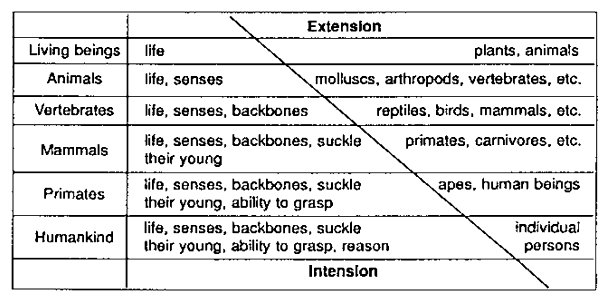
When we compare any two concepts, the concept whose intension is broader and extension narrower is called "specific concept" (or subordinate concept), and the concept whose intension is narrower and extention broader is called "generic concept" (or superordinate concept). For example, when we compare the concept of vertebrate with the concept of reptile, the former is a generic concept in relationship to the latter; and the latter is a specific concept in relationship to the former. Also, when we compare the concept of animal with the concept of mollusk, the former is a generic concept, and the latter is a specific concept. If we repeat this operation over and over again, we will eventually reach the highest generic concept, beyond which no other concept can be traced. Such concepts are called "categories" (Fig. 10-2). In addition, the pure concepts that reason has by nature (rather than through experience) are also called categories. These categories vary from philosopher to philosopher. The reason is that the most important fundamental concepts in each thought system are considered categories. Accordingly, the meaning of categories vary from philosopher to philosopher.
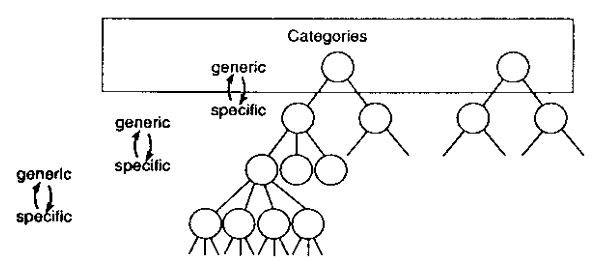
Aristotle was the first philosopher to establish categories. He set up the following ten categories, taking clues from grammar:
In the modern age, Kant established 12 categories, which were mentioned in "Epistemology."
3. Judgment
An assertion of something about a certain object is called a Judgment." Logically, a judgment is an affirmation or denial of a relation among certain concepts. When expressed in language, a judgment is called a proposition.
A judgment consists of the three elements of subject, predicate, and copula. The object to which a thinking is directed is the subject; the predicate describes its content; and the copula connects the two. Generally, the subject is expressed as 'S', predicate as 'P', and copula as a judgement is formulated as "S-P."
As for the kinds of judgment, the twelve forms of judgment proposed by Kant are still employed in formal logic today. (Based on these forms of judgment, Kant derived his twelve categories.) Kant's twelve forms of judgment are as follows:
Of the above forms of judgment, the most basic is the categorical judgment. If the universal and particular forms of judgment concerning quantity, and the affirmative and negative forms of judgment concerning quality are combined with the categorical judgment, the following four kinds of judgment can be obtained:
Universal Affirmative judgment: Universal Negative judgment: Particular Affirmative judgment: Particular Negative judgment:
The codes of A, E, I and 0 derive from the first two vowels of the Latin words affirmo ("affirm" A, I) and nego ("negate" E, O).
d) Distributed and Undistributed Terms
When making a categorical judgment, one must examine the relationship between the extension of the subject and that of the predicate. When a term applies to the proposition throughout its entire extension, that term is said to be "distributed." When the term applies to only a part of its extension, that term is said to be undistributed."
For example, in the universal affirmative judgment "Every man (S) is an animal (P)" judgment A), the subject is distributed while the predicate is undistributed (Fig. 10-3). In other words, the term "man" applies to the proposition "every man is an animal," throughout its entire extension, but the same is not true about the term animal.

In the universal negative judgment (judgment E) "No man is a plant," both subject and predicate are distributed (Fig. 10-4).
4. Inference
Inference refers to the process of reasoning whereby a proposition is derived from one or more propositions. The propositions which are already known are called "premises," and the proposition derived from them is called "conclusion." In this process, there are deductive inference and inductive inferences. Let us first deal with deductive inferences. When there is only one proposition, which is used as the premise, the inference is called direct inference." When there are two or more propositions as the premise, it is called an "indirect inference." Indirect inference will be introduced here.
When a conclusion is derived from two premises, we have a "syllogism," which can be categorical, hypothetical, disjunctive, or dilemma. The following is an example of a categorical syllogism:
Here, of the three concepts ("Socrates," "man" and "mortal"), "mortal" has the greatest extension; therefore, it is called the "major term." Next, "Socrates" has the smallest in extension; therefore, it is called the "minor term." The extension of "man" is between the two; therefore, it is called the "middle term." If we label the major term as P, the minor term as S, and the middle term as M, the above example can be indicated as:
Between the two premises, the one containing P is called the "major premise," and the one containing S is called the "minor premise."
5. Induction and Analogy
The method by which one attempts to reach a general assertion from a number of observed particular facts is called inductive inference, or induction. It is regarded as an application of the syllogism. The following is an example of induction:
Horses, dogs, chickens, and cows are mortal. Horses, dogs, chickens, and cows are animals. Therefore, all animals are mortal.
This syllogism makes the mistake of the minor term being unduly distributed (the fallacy of illicit minor); still such inductive inferences are possible in natural science because of the "principle of uniformity in nature" and the "law of causality." The former means that all phenomena in the natural world have the same form, and the latter means that there are always cause and effect in natural phenomena.
Analogy refers to the inference through which, based on similarities, other particular phenomena are inferred from known particular phenomena. This is regarded as a kind of induction. For example, the following is an analogy: For the existence of living beings, water, air, appropriate temperature, and so on, are required.
On Mars there are water, air, appropriate temperature, and so on. Therefore, there probably exist living beings on Mars. Because this syllogism makes the mistake of an undistributed middle concept (fallacy of undistributed middle), the conclusion has merely the value of probability. But if the middle concept is distributed (that is, if all the necessary conditions for the existence of living beings are given), the conclusion becomes certain.
B. Hegel's Logic
1. The Characteristic of Hegel's Logic
Hegel's logic deals with the development of God's thinking, prior to the creation of the world, and is called heavenly logic. 2 However, unlike formal logic, it does not merely deal with the formal laws of thought. Although it holds itself to be the development of God's thinking, it attempts to deal with the most universal definitions and laws of reality.
2. Outline of Hegel's Logic
Hegel's logic consists of three branches, namely, the Doctrine of Being, the Doctrine of Essence, and the Doctrine of Notion. These three branches are each subdivided, such that the Doctrine of Being consists of Quality, Quantity, and Measure; the Doctrine of Essence consists of Essence, Appearance, and Actuality; and the Doctrine of Notion consists of Subjective Notion, Objective Notion and the Idea, and these are each, further subdivided. For example, Quality in the Doctrine of Being consists of Being, Determinate Being, and Being-for-Itself, and Being further consists of Being, Nothing, and Becoming.
The starting point of the development of Hegel's logic is the dialectic of Being-Nothing-Becoming. After passing through these three stages, Being moves on to Determinate Being. This Determinate Being has three further stages, and after passing through them, the Determinate Being moves on to Being-for-Self. Being-for-Self has three additional stages, and when they are gone through, it moves on to Quantity. Quantity moves on to Measure by passing through its own three stages, and when Measure has passed through its three stages, the theory concerning Being comes to an end.
Next is the theory concerning Essence. Hegel's logic moves from Essence to Appearance, and from Appearance to Actuality. Then comes the theory concerning the Notion. Notion moves from subjective Notion to Objective Notion, and from Objective Notion to the Idea. Within the Idea, there are three stages, namely, Life, Cognition, and the Absolute Idea. The Absolute Idea is the final destination in the development within logic.
Then the world of logic or the world of Idea negate itself, in order to realize itself truly, and moves on to the realm of Nature. According to Hegel, Idea moves on to become external to itself, in other words, Nature is the self-alienation of Idea, the negative of Idea, and Idea in the form of otherness. There are three stages of Mechanics, Physics and Organics in the realm of Nature.
Furthermore, Idea, which externalizes itself by negating itself, returns to its original self by further negating the negation. Idea as having recovered itself through human being is Spirit. Spirit passes through the three stages of Subjective Spirit, Objective Spirit, and Absolute Spirit. The Absolute Spirit stands at the highest point in the development of Spirit. The Absolute Spirit develops itself by passing through the three stages of Art, Religion, and Philosophy. The above description of Hegel's system can be illustrated in the following diagram (Fig. 10-5).
3. The Dialectic of Being-Nothing-Becoming
Hegel's logic, starting with Being, deals with the process of reaching the Absolute Idea. In this section, I will examine the initial dialectic of Being-Nothing-Becoming in the Doctrine of Being, because this portion constitutes the core of Hegel's logic.
Hegel's logic starts with Being. 3 Being means simply that which exists, but this is the most abstract of all concepts, and is an entirely indeterminate, empty thought. Therefore, lie says it is negative, namely, Nothing. For Hegel, Being and Nothing are both empty concepts, and there is little distinction between the two. 4 Next, Hegel says that the unity of Being and Nothing is Becoming. Both Being and Nothing are empty abstractions, but Becoming, which is the unity of the two opposites, is the first concrete thought. 5 With this logic of Being-Nothing-Becoming as the basis, the logics of thesis-antithesis-synthesis, affirmation-negation-negation of negation, etc., which are usually regarded as Hegel's method, came to be established.

4. Determinate Being
Having examined Being-Nothing-Becoming, we move on to the examination of the Determinate Being.
Determinate Being is Being with a certain form, Being considered concretely. While Being means simply to that which exists, Determinate Being means that which is something. Moving from Being-Nothing-Becoming to Determinate Being, in short, means moving from the abstract to the concrete. Becoming is a contradiction containing Being and Nothing within itself, and through this contradiction, Becoming transcends itself to become Determinate Being.
In this way, Determinate Being is a definite Being, a qualified Being. This determinateness of Determinate Being was called Quality by Hegel. However, even though we may say determinate, what is considered here is simple determination.
The determination that makes Being a Determinate Being implies the affirmative content of something, and at the same time, it implies limitation. Therefore, the quality that makes something what it is, is reality, when seen from the affirmative aspect of something, and at the same time it is negation when seen from the aspect of not being other thing. Therefore, in Determinate Being, reality and negation, or affirmation and negation, are united. Next, Determinate Being proceeds to Being-for-Self. Being-for-Self refers to the Being that is not related to another thing, nor changes into another thing, but stays as itself in every way.
5. Being-Essence-Notion
In the Doctrine of Being, starting from an analysis of what it is to exist, Hegel discussed the logic of change, or the logic of generation and disappearance. Next, the Doctrine of Being proceeds to the Doctrine of Essence. Here, the unchangeable aspect within things and the interconnectedness among all things are discussed. Next, it proceeds to the Doctrine of the Notion as the unity of the Doctrine of Being and the Doctrine of Essence. Here, the fact that things do not cease to be themselves while changing into other beings-that is, self-development-is discussed. The driving force of this development is the notion and life.
Why then can one say that God's thinking proceeded in the way of Being-Essence-Notion? One can understand this if he or she watches the process of his or her cognition as lie or she perceives things from externally to internally, lie says. In the case of perceiving a flower, for example, we first perceive the existence of the flower phenomenally.
Next, we perceive the essence of the flower. Then, the notion of the flower is formed, in which the existence of the flower and the essence of the flower are united.
6. Logic-Nature-Spirit
As mentioned before, nature according to Hegel, is the Idea in the form of otherness, or the Idea as self-alienated.
Therefore, if Logic is made to be the thesis, then Philosophy of Nature becomes the antithesis. Next, nature regains consciousness and freedom through the human being and becomes Spirit. Accordingly, the Philosophy of Spirit becomes the synthesis.
The natural world, also, performs the dialectical development of thesis-antithesis-synthesis, that is, the three stages of Mechanics, Physics, and Organics. This does not mean, however, that nature itself develops, but rather, this is the process through which the Idea behind the natural world manifests itself. First, the concept of force appears; next, the concept of physical phenomena; and then, the concept of living beings, lie says.
Finally, the human being appears, and the Spirit develops itself through humankind. This development takes place in the three stages of Subjective Spirit, Objective Spirit, and Absolute Spirit. Subjective Spirit refers to the spirit of the individual; Objective Spirit refers to the socialized spirit, or the objectified spirit transcending the individual.
Objective Spirit has the three stages of Law, Morality, and Ethics. Law refers not to something systematized like the constitution of a state, but to elementary forms in human relationships, like a group of people. Next, man comes to respect the rights of others and to lead a moral life. However, there are still many subjective aspects (individual aspects) there. Thus, ethics appears as the norms that everyone should communally observe. The first stage in ethics is the family. In the family, the members are linked with one another through love, and there is freedom there.
However, in the stage of civil society, the interests of individuals conflict with one another, and freedom becomes restricted. Thus, the state, which integrates the family and civil society, appears. Hegel considered that the Idea would manifest itself fully through the state. The state in which the Idea is actualized is the rational state. Human freedom will be fully actualized in that state.
Finally, there appears the Absolute Spirit. The Absolute Spirit manifests itself through the three stages of art, religion, and philosophy. When it comes to the stage of philosophy, the Idea regains itself. The dialectical movement of the Idea returns to the origin in this way. Nature appears; the human being appears; the state appears; art, religion, and philosophy appear; and finally Idea returns to the perfect Idea (God). By accomplishing this return, the entire process of development comes to an end (Fig. 10-6).6
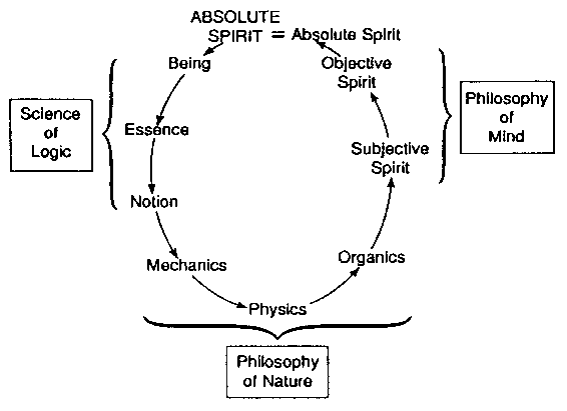
C. Dialectical Logic (Marxist Logic)
According to Hegel, the Idea manifest itself as nature in the clothing of matter; therefore, objective reality is the Idea. Marx, however, asserted that objective reality is matter, and that ideas (concepts) are merely the reflections of the material world on human consciousness. Yet Marx accepted, without change, Hegel's dialectic of thesis-antithesis-synthesis, and asserted that it is in fact the form of material development. Accordingly, in opposition to Hegel's "idealistic dialectic," Marx's dialectic is called "materialist dialectic." The logic established in accordance with the materialist dialectic is dialectical logic. Its original characteristic is its opposition to formal logic, especially to the law of identity and the law of contradiction. 7 That is because, according to dialectical logic, in order for things to develop, A should be A and at the same time it should be not-A; and because the laws of thought should be the reflection of the material development of things. Marxists assumed that the forms and laws of thinking advocated by formal logic belong to the superstructure and have a class nature, and that they should reject them and create a new dialectical logic, in opposition to formal logic. 8 However, if formal logic was to be rejected, then one would inevitably run into a difficulty: without formal logic, it is impossible to conduct coherent and correct thinking.
Therefore, in 1950, Stalin published a paper entitled "Marxism and Problems of Linguistics," expressing that language does not belong to the superstructure nor does it have a class nature. With this thesis as the starting point, a series of discussions took place in the Soviet Union from 1950 to 1951 on the subject of how to evaluate formal logic. From those discussions, the conclusion was reached that the forms and laws of formal logic do not belong to the superstructure and do not have a class nature. It was also decided that, while formal logic deals with elementary laws and forms of thinking, dialectical logic is a higher logic concerning the laws of development of objective reality and of thinking, which is the reflection of objective reality." 9 Yet, the logic based on materialist dialectic, namely, dialectical logic, makes only basic assertions. As a matter of fact, it has not been systematized as of yet. 10
D. Symbolic Logic
Symbolic logic, which is a development of formal logic, is an attempt accurately to research the correct method of judgment by using mathematical symbols. Symbolic logic contrasts with formal logic in important ways. In formal logic, the subject matter is the relationship of implication between terms, that is, the relationship of implication between the subject and the predicate in a proposition. In contrast, symbolic logic focuses on the connection between terms, or between propositions, and its subject-matter is the study of the laws of thought through the use of mathematical symbols.
The five basic forms of connection between propositions are as follow (where p and q are two propositions):

Through the combination of these five basic forms, any complicated deductive inference can be accurately expressed. For example, the basic laws of formal logic, namely, the law of identity, law of contradiction, and law of the excluded middle, can be symbolized as follows:

Philosophers proposed great thought systems, but the question is whether or not their logical constructions are correct. In order to ascertain their correctness, we need to use mathematical symbols and make calculations. Symbolic logic came into being from such a point of view.
E. Transcendental Logic
Kant's logic is called transcendental logic. Concerning the question of how objective knowledge can be obtained, Kant considered that objective knowledge can be obtained by thinking, through the forms of thought (forms of understanding), about the sensory content gained through the forms of intuition.
Kant divided the way of judgment into four types: quantity, quality, relation, and mode. Further, lie divided each of these into three kinds, establishing twelve forms of judgment. Based upon these forms, he established twelve forms of thought, or twelve categories. A category is the most basic framework through which we think. Categories are also called a priori concepts.
Ordinary logic, following Aristotle's formal logic, has dealt with the general forms and laws of thought, without considering the object of thought. Kant's logic, however, was epistemological logic, aiming to verify the knowledge concerning the object.
II. Unification Logic
A. Basic Postulates
1. The Starting Point and Direction of Thinking
Traditional systems of logic have focused primarily on laws and forms of thought, but Unification Logic begins by considering, first of all, the starting point of thinking. Unification Logic starts from the question as to why thinking takes place, and then deals with the forms and laws of thought.
Why does the human being think? The reason is that, in creating the universe-specifically, prior to the creation of the universe the first thing that God did was to form Logos (the Word) in His mind. Therefore, the human being, who was created in the resemblance of God, is likewise supposed to think.
Then, for what purpose does the human being think? The human being thinks in order to actualize the purpose of creation, which is motivated by love. For created beings, the purpose of creation is to accomplish both the purpose for the whole and the purpose for the individual. The purpose for the whole is to serve, with love, one's family, neighbors, nation, and all humankind, to please them, and moreover, to please God. The purpose for the individual is to satisfy one's own desires. Ultimately, these dual purposes are the purposes for which the human being should live. For these purposes, the human being thinks. Between the purpose for the whole and the purpose for the individual, the former should be given priority.
Therefore, thinking is to be carried out primarily to actualize the purpose for the whole, and secondarily to actualize the purpose for the individual. That is to say, originally human beings are supposed to think not centering on satisfying their own individual purpose, but centering on loving others.
2. The Standard of Thinking
Unification logic, similarly to ontology and epistemology, has its theoretical starting point in the Original Image. Thus, in order to verify that a theory concerning the phenomena] world is correct and truthful, one must go back to the starting point of creation and find its standard in the Original Image. That is the fundamental position of Unification Logic. Therefore, the standard of thinking is derived from the standard of the logical structure of the Original Image.
3. Related Areas
Not only the structure of human logic, but also the structure of human cognition and the structure of existence of all things are based on the structure of the Original Image. Furthermore, the structure of the way in which the human being acts in relationship to the natural world, that is, the structure of the exercise of dominion over all things, is also based on the structure of the Original Image, as explained in the formation of the outer four-position base in the "Theory of the Original Image." In this way, the logical structure, the cognitive structure, the structure of existence, and the structure of dominion are all based on the structure of the Original Image. It is only natural, then, that we find mutual relationships among these structures. This means that logic has something to do with epistemology, with ontology, and with the practical aspects of education, ethics, and so forth. Thus, one of the basic postulates of Unification Logic is that it is connected with various other fields (Fig. 10-7).
B. The Logical Structure of the Original Image
Within the Original Image, the structure that becomes the standard for thinking is the Inner Developmental Four-position Base (Fig. 10-8). As explained in the "Theory of the Original Image," the Inner Sungsang and the Inner Hyungsang enter into give-and-receive action centering on purpose, and as a result produce Logos (reason-law) within the mind of God. Thus, the structure that forms Logos is the Inner Developmental Four-position Base.
In the formation of Logos, there is Heart behind purpose; thus, purpose is established on the basis of Heart. In the direction of actualizing purpose, the Inner Sungsang and the Inner Hyungsang enter into give-and-receive action. That is, the reason God engaged in thinking and established Logos was to fulfill the purpose of creation, which is the purpose of obtaining joy by loving His objects.
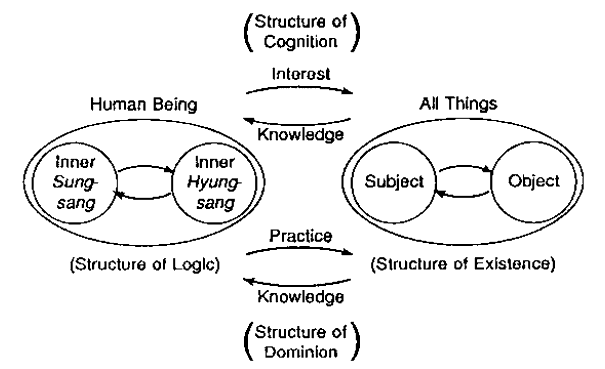
Accordingly, originally, human thinking should also be motivated by Heart (love). That is to say, the human being must think in order to realize the ideal world of creation (the world of love, the world of peace) by loving one another. However, reality has not been so. This is because the human being is fallen. In fallen people, in most cases, thinking (the formation of the inner developmental four-position base) is made not on a Heart-centered purpose, but on a self-centered purpose. Therefore, when the inner Sungsang and the inner Hyungsang engage in give-and-receive action, evil thoughts naturally come into being.
To this day, numerous religious leaders have appeared and preached that we should not have evil thoughts.
Philosophers, also, have pursued the right way of thinking. Yet, neither religious leaders nor philosophers have been able to show clearly the standard according to which one should think. With regard to this question, Unification Thought asserts that the structure of the formation of Logos in the Original Image is the standard for human thinking.
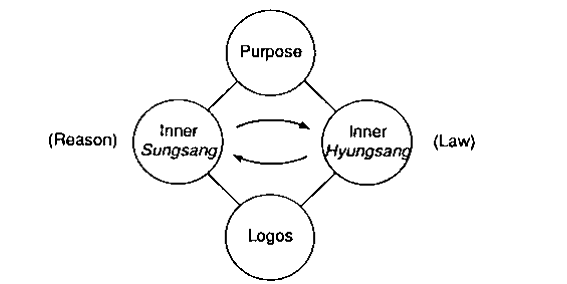
In the Original Image, after Logos has been formed, it enters into give-and-receive action with the Original Hyungsang and forms the outer four-position base. Thus, God's thinking is actualized in the phenomenal world. The formation of Logos and the subsequent creation of the phenomenal world is the two-stage structure of creation in the Original Image. The structure of logic that serves as the standard for thinking corresponds to the inner developmental four-position base in the first stage of the two-stage structure and it is deeply connected with the outer developmental four-position base in the next stage (Fig. 10-9). Accordingly, our thinking should not come to an end with thinking alone, but should proceed toward practicing what was thought. In other words, thinking must proceed toward practice.
C. The Two Stages in the Process of Thinking and the Formation of the Four-Position Base
1. The Stage of Understanding and the Stage of Reason
In cognition, there are three stages: the sensory stage, the understanding stage, and the rational stage. This corresponds to the Unification Thought law of completion through three stages. Since the sensory stage is the entrance through which information comes in from the outside, it is the formation stage of cognition; thinking is conducted in the growth stage of understanding and in the completion stage of reason. In the understanding stage, thinking is affected by the information from the outside; in the rational stage, however, thinking is carried out freely.
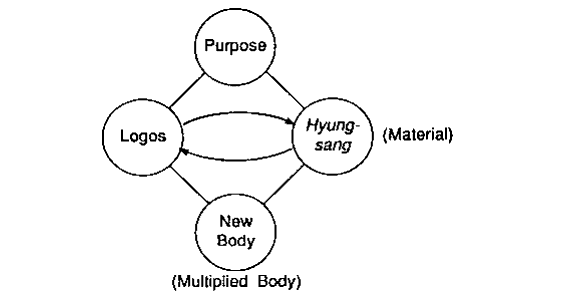
Kant, also, speaks of the three stages of cognition. The stage where one receives the sensory content coming from the outside through the form of intuition is the sensory stage; the stage where one thinks through the forms of thought (forms of understanding), is the stage of understanding, and that which unifies and controls cognition in the surge of understanding is the stage of reason. 11 In the case of Marxism, the stage in which the sensory content is reflected on the brain is the sensory stage.
Next is the logical stage, or the rational stage, in which judgment and inference take place. Beyond that there is the stage of practice, in which truth is confirmed through practice. In the case of Marxism, the forms of thought are reflections of the forms of existence in the external world.
In terms of cerebral physiology, as was explained in the chapter on Epistemology, it is considered that the sensory stage of thinking takes place in the sensory center; the understanding stage, in the parietal association area; and the rational stage, in the frontal association area.
In the understanding stage and in the rational stage, a logical structure resembling the structure of the Original Image is formed. In the understanding stage, thinking is restricted by the sensory elements (content) entering from the outside. The content of the external world and the prototype of the internal world are collated, completing cognition up to that point. Then, an internal, completed (identity-maintaining) four-position base is formed as the cognitive structure, or logical structure. In the rational stage, thinking is free to grow on the basis of the knowledge obtained in the understanding stage; here, a new conception, or a plan (a multiplied body), can be established. The structure at this point is the inner developmental four-position base.
Figuratively speaking, the sensory center (sensibility) corresponds to the entrance of a house; the parietal association area (understanding) corresponds to the reception room; and the frontal association area (reason) corresponds to the living room or study. When informed of the visit of a guest, the host receives the guest in the reception room. At that point, the host tries to understand what the guest says while meeting the guest face to face. At this time, the host is not in a position to think freely about just anything he chooses, because his thinking is shaped by his conversation with the guest. This can be compared to the stage of understanding.
But when the visit is over, the host can retire to a private room and think freely about anything, referring back to what the guest has said. This can be compared to the rational stage.
2. The Development of Thinking in the Stage of Reason
In the stage of reason, how does the four-position base develop? First, through the give-and-receive action between the inner Sungsang and the inner Hyungsang, the logos of the first step, namely, a plan (a multiplied body) is formed as the conclusion of the thinking. This sometimes concludes the process, but in most cases, based upon that conclusion the logos (a plan) of the next step is formed. The logos formed at the first step has been stored in the inner Hyungsang as an idea or a concept and is mobilized as material for the next step of thinking, together with many other materials (ideas, concepts, etc.). In this way, the logos of the second step is formed, which is again stored in the inner Hyungsang to be mobilized in further thinking. Then the third-step logos comes to be formed. Thus, thinking continues endlessly. This is the process of forming the four-position base in the rational stage. It is called the development of thinking in a spiral form (Fig. 10-10).
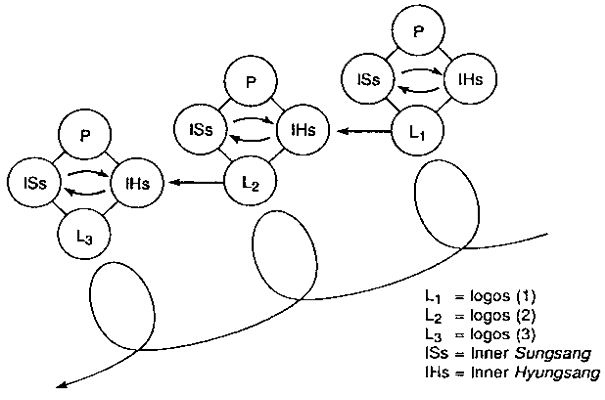
Thus, thinking continues to develop infinitely in the rational stage, forming a developmental four-position base. However, the development of thinking consists of the successive formation of completed four-position bases, as we can see from the above explanation that once a step is completed, a new step begins. Therefore, thinking develops by repeating these completed steps.
D. Basic Forms of Thought
Thinking (or cognition) at the stage of understanding takes place with the _____ content and prototypes entering into give-and-receive action centering on purpose. First, the purpose must be properly established.
The correct purpose refers to the purpose of creation based on Heart (love).
As explained in the chapter on Epistemology, the protoimages and the images of relation formed in the protoconsciousness are connected with the subconscious within the lower center through the peripheral nerves. These are a priori prototypes (original prototypes) with which human beings are born. The images of relation become the forms of thought, which put certain restrictions on cognition, or thinking.
The subconscious in the lower center has certain forms (images of form). Suppose, for example, that an individual has appendicitis. The lower center, which integrates protoconsciousness, knows in advance the information concerning the Sung-sang and Hyungsang (functions and structure) peculiar to the appendix.
Therefore, the lower center immediately perceives an abnormality. Thus, the lower center sends an appropriate instruction for the appendix to return to its original, normal condition.
When the movement of the stomach is too strong, it can cause convulsions, and when the movement is too weak, it can cause gastric ptosis; the lower center knows the information concerning the strength of the stomach movement. When the movement is too strong or too weak, the lower center controls the strength properly. This kind of information is related to yang and yin.
The cell has a nucleus and cytoplasm, and the nucleus controls the cytoplasm. The nucleus and cytoplasm are in the relationship of subject and object. The subconscious of the lower center has information concerning subject and object within the cell.
The subconscious also has the sense of time and space. Thus, when infection occurs somewhere within the physical body, the subconscious sends white blood corpuscles there and tries to cure it.
The subconscious, also, knows the relationship between finite and infinite. For example, red blood corpuscles die after they have lived for a certain period of time. In that way, new cells are continually being created within the body, and old cells die away. The subconscious is aware of this finitude. In the body, there are also cells and organs that exist and function while maintaining their durability, perpetuity, and cyclic nature. The subconscious knows this infinity (i.e., durability, perpetuity, cyclicalness) as well.
In this way, the subconscious of the lower center knows the forms of Sungsang and Hyungsang, yang and yin, subject and object, time and space, finitude and infinite, etc. The images of these correlations reflected in the subconsciousness are the images of form, which are sent to the cerebral center and become the forms of thought in thinking.
The role that the forms of thought play in thinking can be explained by comparing it with a soccer game. In a soccer game, the players run and kick the ball as they please; yet, they do it while following certain rules.
Likewise, reason proceeds with thinking freely, but thinking is made with certain forms, which are under the influence of the images of form.
Forms of thought are otherwise called categories. In Unification Thought, categories are established on the basis of the principles of the four-position base and give-and-receive action. This is because the four-position base and give-and-receive action are the core of Unification Thought. First, ten basic categories are established, the meaning of which has been explained in the chapter on Epistemology.
In the past, many thinkers established various categories, and among those categories, there are many that are related to the categories of Unification Thought. For example, there is the category of essence and phenomenon, which corresponds to the Unification Thought category of Sungsang and Hyungsang.
Categories are divided into primary and secondary. The primary categories are the ten basic forms peculiar to Unification Thought. The secondary categories are developed on the basis of the primary categories. Among these, there are some that correspond to the categories of traditional philosophy. The following is a list of the primary and secondary categories. There is no particular limit to the number of secondary categories: here, only a few are mentioned.
Sungsang & Hyungsang, among the primary categories, resemble Essence & Phenomenon or Content & Form. why use such a new, uncommon term? What constitutes the fundamentals of Unification Thought are such concepts as four-position base, Chung-Boon-Hap Action, give-and-receive action, and so on. If these were to be taken away, it would mean that Unification Thought would lose its skeleton. Therefore, we cannot but use these terms as categories of Unification Thought.
Categories and thought systems are closely related. It can be said that when one sees the categories of a thought system, one knows the thought system itself, and when one grasps a thought system, one knows its categories. Categories are the signboard of a thought system. Since Unification Thought is a new thought, it is natural to establish categories with new terms appropriate to this new thought.
Marx's thought has Marxian categories; Kant's thought has Kantian categories; and Hegel's thought has Hegelian categories. Likewise, Unification Thought must have Unification Thought categories, showing the characteristics of Unification Thought. These are the ten basic forms constituting its primary categories.
E. Basic Laws of Thought
In formal logic, the basic laws of thought are the law of identity, the law of contradiction, the law of excluded middle, and the law of sufficient reason. From the perspective of Unification Thought, there is an even more basic law, namely, the law of give-and-receive.
What forms the standard of thought is the structure of the Original Image. The structure of the Original Image is the four-position base, which is formed through give-and-receive action. Accordingly, the most basic law of human thinking is the law of give-and-receive action, or the law of give-and-receive. It is on the basis of this law that the law of identity, the law of contradiction, and so oil, are established.
In formal logic, sentential connectives, such as "and," "or," "not," and "if ... then," constitute the framework of logic. Without such connectives, no proposition could be established, and no inference, made. From the perspective of Unification Thought, the propositions or inferences that contain such connectives are established on the basis of the contrast-type give-and-receive action. The connectives are playing the role of determining the correlative relationship between terms within a proposition, or between propositions within an inference.
Logical laws can be expressed by using connectives. This so because logical laws put forth the rules for the use of connectives. For example, the syllogism, which is a typical deductive inference, can be expressed using connectives in the following way: "If A (the major premise) and B (the minor premise), then C (conclusion)." Consider, for instance, the following syllogism: Man is mortal. Socrates is a man. Therefore, Socrates is mortal.
When we compare the proposition "Man is mortal" (the major premise) and the proposition "Socrates is a man" (the minor premise), die extension of man is broader than that of Socrates and Socrates is included in man. Therefore, after all, we come to the conclusion that "Socrates is mortal." Consequently, this is a contrast-type give-and-receive action (Fig. 10-11).
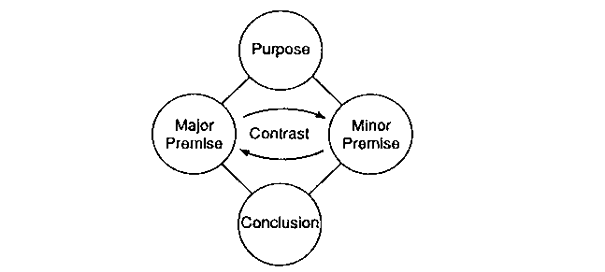
Furthermore, each proposition is composed through the give-and-receive law as well. In the major premise above, we compare man" and "mortality," and we derive the conclusion that "man is mortal." Therefore, here also, a contrast-type give-and-receive action takes place (Fig. 10-12).
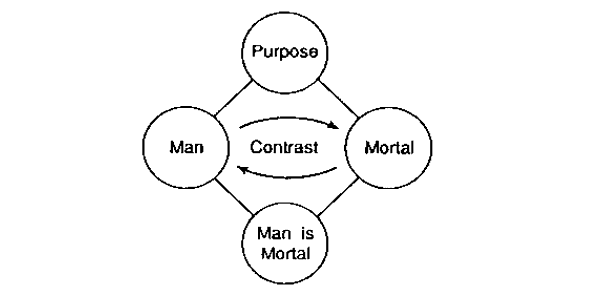
The next question to be considered is that of law and freedom in thinking. If thinking follows laws, what kind of freedom is there in thinking? As mentioned before, the Inner Sungsang and the Inner Hyungsang engage in give-and-receive action, and Logos appears. Reason within the Inner Sungsang has freedom. On the other hand, laws within the inner Hyungsang are already determined, and cannot be changed.
Then, what is freedom in reason? There are various ideas and concepts in the Inner Hyungsang. Freedom in reason means that reason is free to choose from among those ideas and concepts. Therefore, though the purpose and direction of thinking are determined, what kind of plan is established depends on the freedom of each person. The human being has innumerable ideas and concepts acquired through experience. Out of these, a person can choose freely and produce a new conception, or plan, through composing or associating them.
This is the meaning of freedom in reason, or freedom of thought.
III. An Appraisal of Traditional Systems of Logic from the Perspective of Unification Thought
A. Formal Logic
To formal logic itself, Unification Logic has nothing to oppose. That is to say, Unification Logic approves the laws and forms of thought dealt with in formal logic just as they are. Nevertheless, human thinking has not only the aspect of form, but also the aspect of content. Also, thinking has purpose, direction, and relations with other areas (areas of cognition, dominion, ontology). That is to say, thinking is not for the sake of thinking itself, but rather for the sake of cognition and practice (dominion), and for the sake of actualizing the purpose of creation. That is, the laws of thought are merely conditions for thinking to take place.
B. Hegel's Logic
Hegel's logic tried to interpret philosophically the way God had created the universe. Hegel understood God as Logos, or the Idea, and considered Idea to be the starting point of the creation of the universe.
Hegel first explained the development of Being-Nothing-Becoming in the world of Idea. Since Being as it is has no development, lie thought of Nothing as something to be opposed to Being. Then, as the unity of the opposition between Being and Nothing, Becoming comes into being, he held. There is a problem in this view, however. For Hegel, Nothing originally is merely an interpretation of Being, and Being and Nothing are not separated. 12 However, Hegel separated Being and Nothing, and explained as if Being and Nothing were opposed to each other.
Another problem is that he held that Idea develops itself. From the perspective of Unification Thought, idea belongs to the Inner Hyungsang in the structure of the Original Image; as the functions of intellect, emotion, and will-particularly reason within the function of intellect-act upon the idea centering on purpose, the Logos (conception or plan) is formed, which becomes a new idea. Accordingly, Logos, or Idea, is something formed within the mind of God, and there can never be the case that Idea develops by itself.
Criticizing the "self-development of the Idea" advocated by Hegel, Max von Ramelin, of Tubingen University, said: The amount of effort we have made to understand the meaning that Hegel's so-called speculative method had for its founder, Hegel, is beyond description. Every person thinking of other people and shaking his head, would ask, "Do you understand? Without your doing anything, will the Idea move by itself within your mind?" We were told that those who answer yes are people with a speculative brain. We, who were different from them, merely stood at the stage of thinking in the category of limited understanding. ...In our minds, the reason we had failed fully to understand that method was the dullness of our own talents; we did not have enough courage to consider that the reason lay in the very lack of clarity and in the defects of the method itself. 13 Further, Hegel held nature to be the self-alienation, or the form of otherness, of Idea. As was pointed out in the Theory of the Original Image, this view regards nature as the expression of God, and is a view that can lead to pantheism, placing no distinction between nature and God. Thus, it has the tendency to turn easily into materialism.
In Hegel's dialectic, nature was merely an intermediate step in the process leading to the appearance of humankind.
Nature is like the scaffolding of a building tinder construction. Once the building is completed, the scaffolding, which was made as a means to construct the building, is taken away. Likewise, once humankind came into being, nature became meaningless in itself.
He also said that the human being is manipulated by reason in history. Consequently, the human being actually is a being to be manipulated like a puppet by the Absolute Spirit. From the perspective of Unification Thought, however, God is not unilaterally moving history. History is made through the combination of the human being's portion of responsibility and God's portion of responsibility.
Furthermore, Hegel's dialectic has cyclic, returning, and completing nature. In history, he regarded Prussia as the rational state that had emerged at the end of history. If that were true, history would have been completed at the time of Prussia, and there could be no further development. Therefore, it follows that Hegel's philosophy came to an end with the end of Prussia.
Problems such as these are numerous in Hegel's philosophy. We must say that the cause of these mistakes is found in his logic. Let us examine this point further.
Hegel grasped the development of Idea as the dialectical development of thesis-antithesis-synthesis. The Idea alienates itself and becomes nature; and later, by becoming spirit through humankind, it recovers itself. According to Hans Leisegang, this way of thinking is unique to Hegel, and is based on his study of the Bible. Specifically, Hegel's philosophy of opposition, which is transcended by a higher synthesis, is said to be based on the theme of certain passages from the Gospel according to John, such as "Unless a grain of wheat falls into the earth and dies, it remains alone; but if it dies, it bears much fruit," and "I am the resurrection and the life; he who believes in me, though lie dies, yet shall lie live." 14 From this position, Hegel conceived of God as Logos, or Idea, and held that God manifests Himself in the external world just as the life of a seed sown on the earth manifests itself in the outside. Here lies the fundamental cause of Hegel's errors.
From the perspective of Unification Thought, God is a God of Heart (love), and having established the purpose of creation motivated by Heart -- emotional impulse to be joyful by loving the object-He created the universe. Logos was the plan for creation in God's mind, and was not God Himself. In Hegel's idealistic dialectic, however, God's Heart (love) or His purpose of creation are not mentioned. In Hegel, God is not explained as God the Creator, but rather as a kind of life that germinates and grows.
At this point, let us compare Hegel's logic and Unification Thought logic. What Hegel calls Logos corresponds, in Unification Thought, to God's conception of, or plan for, creation. The process described as the dialectic of Logos in Hegel corresponds, in Unification Thought, to the give-and-receive action in the Original Image. Hegel's thesis-anti thesis-synthesis corresponds to the Origin-Division-Union Action in Unification Thought. Hegel's dialectic, which has a returning and completing nature, can be understood, according to Unification Thought, as the spiral developmental movement in nature through give-and-receive action centered on the purpose of creation, and in history, as the history of re-creation and restoration. Hegel tried to find the Idea through nature, but Unification Thought holds that one can perceive the Original Image (Divine Image and Divine Character) through all things symbolically. Therefore, Hegel's pantheistic nature can be overcome by the Unification Thought Theory of Pan-Divine Image, the view that the Divine Image is manifested in all created beings.
C. Dialectical Logic
As mentioned before, as a result of the controversy triggered by Stalin's paper entitled "Marxism and Problems of Linguistics," the assertion that formal logic belongs to the superstructure and has a class nature was rejected and the conclusion was reached that the law of identity and the law of contradiction in formal logic should be recognized.
However, if the law of identity and the law of contradiction in formal logic are to be recognized as the laws of thought, it means that in the framework of Communist theory, the objective world follows the dialectical law of contradiction (the law of the unity and struggle of opposites) while thinking follows the law of identity and the law of contradiction. This, however, is not in agreement with the basic tenet of materialist dialectic that thinking is a reflection of the objective world. Such difficulty (aporia) occurred. 15 In this way, according to materialist dialectic, the objective world develops through the dialectical law of contradiction, while unchangeability and identity-maintenance in thinking are recognized. On the other hand, it is the assertion of Unification Thought that changeability (developmental nature) and unchangeability are united in the objective world as well as in thinking.
Thinking (or cognition) in the stage of understanding has mainly an identity-maintaining nature, because cognition is completed for the time being by collating the sensory content coming from the external world with the prototypes from within. However, thinking becomes developmental in the rational stage. Still, thinking develops step by step; therefore, thinking has an aspect of completion as well (that is, an identity-maintaining aspect) in each of these steps. Accordingly, the law of identity and the law of contradiction are naturally recognized in Unification Thought.
More precisely, what does it mean that materialist dialectic has come to recognize formal logic, that is, the laws of identity and of contradiction, to have come to be recognized by materialist dialectic? Originally, the basic assertion by materialist dialectic was that things should be understood as continually changing and developing. However, the fact that materialist dialectic has recognized the laws of identity and of contradiction means that it has come to affirm the unchanging nature of things, even if only with regard to thinking. That has brought about a change in the essential nature of' materialist dialectic. This is the same as a revision, or collapse, of materialist dialectic. At the same time, it proves that the assertion of Unification Thought, which views things as the unity of identity-maintenance and development, is correct.
D. Symbolic Logic
It is important to pursue accuracy or rigor in thinking, and there is no reason why we should oppose symbolic logic from that perspective. No one, however, can fully grasp human thinking by mathematical rigor alone.
In the Original Image, Logos is formed through the give-and-receive action between the Inner Sungsang and the Inner Hyungsang. Since laws and mathematical principles exist within the Inner Hyungsang, it follows that laws and mathematical principles are contained in Logos; therefore, all things created through Logos manifest laws and mathematical principles. That is why scientists study nature mathematically.
Human thinking has God's Logos as its pattern. Therefore, human thinking naturally involves mathematical principles as well. In other words, it is desirable for thinking to be made with mathematical precision. Here we can recognize the significance of symbolic logic engaging in the mathematical study of thinking.
We should keep in mind, however, that in the give-and-receive action between the Inner Sungsang and Inner Hyungsang, Heart is the center. This means that in the formation of Logos (Word), Heart stands in a position higher than reason and mathematical principles. Therefore, originally, human being is not merely a being of Logos (i.e., a rational or law-abiding being), but more essentially a being with pathos (i.e., a being with heart, or an emotional being). Thus, even if thinking does not have mathematical strictness. if love is contained in thinking, the speaker's meaning can be conveyed sufficiently well to others.
For example, when someone sees a fire and shouts, "Fire!", one cannot know whether he meant to say, "This is a fire" or "There is lire burning." In an emergency, however, if enough emotion calling for help is poured into the utterance, even if there is no grammatical accuracy in the words, people instantly understand the meaning of the utterance.
The human being is originally the union of Logos and Pathos. Therefore, by following only Logos, human being has only half of his or her true value. By being only rational, human being is not fully human; only with emotional aspect can human being be truly human. Therefore, sometimes words that have less accuracy can be more human.
That is, there is an aspect in human thinking that requires strictness, but human being does not always have to express everything accurately and logically. If we examine Jesus' words, we may find many illogical aspects there.
And yet, why are his words great? It is because God's love is contained in them. Thus, even if they may not follow precise logic correctly, they are the truth.
E. Transcendental Logic
Kant asserted that knowledge is acquired by thinking about an object (sensory content) through a priori forms of thought. However, from the perspective of Unification Thought, the object has not only content (sensory content) but also form (forms of existence), and the subject of cognition also has not only form (forms of thought) but also content (image of content). The truthfulness of thinking cannot be guaranteed only by what Kant called the a priori forms and sensory content. In contradistinction to that, in Unification Thought, the necessary relationship between human being and all things lead to the correspondence between the laws and forms of thinking and the laws and forms of the external world, and guarantees the truthfulness of thinking of the object.
F. A Comparison between Unification Logic and Traditional System of Logic
Finally, a diagram presenting a comparative view of Unification logic, formal logic, dialectical logic, and transcendental logic is presented below (Fig. 10-13).
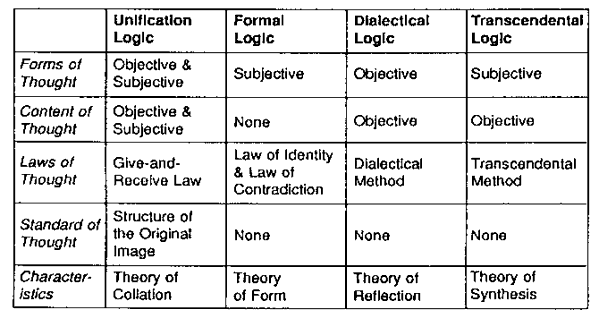
Go Home to True Love
Go to the Contents Page
Go on to Methodology.
